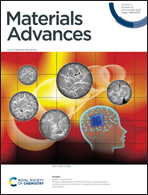Ambient-pressure ozone treatment enables tuning of oxygen vacancy concentration in the La1−xSrxFeO3−δ (0 ≤ x ≤ 1) perovskite oxides†
Abstract
Oxygen vacancies in metal oxides can determine their properties. However, it is difficult to reduce the oxygen vacancy concentration in metal oxides without annealing them under high pressure. In this work, we develop a facile approach to control oxygen vacancy content via an ozone treatment under ambient pressure during cooling. This approach is demonstrated for the synthesis of La1−xSrxFeO3−δ (0 ≤ x ≤ 1, 0 ≤ δ ≤ 0.5x) perovskite oxides – an important class of energy-related materials due to their wide range of non-stoichiometry, mixed ionic and electronic conductivity, and the presence of a rare Fe(IV) oxidation state. A series of La1−xSrxFeO3−δ compounds was initially synthesized using a polymerized complex method. The concentration of oxygen vacancies and Fe(IV) were determined by redox titration, and the crystal structures were derived by analyzing X-ray diffraction patterns using Rietveld refinement. Significant amounts of oxygen vacancies were found in the as-synthesized compounds with x ≥ 0.8: La0.2Sr0.8FeO3−δ (δ = 0.066) and SrFeO3−δ (δ = 0.195). The ambient-pressure ozone treatment approach was able to substantially reduce the amount of oxygen vacancies in these compounds to achieve levels near the oxygen stoichiometry of 3 for La0.2Sr0.8FeO3−δ (δ = 0.006) and SrFeO3−δ (δ = 0.021). The oxygenation/deoxygenation kinetics can be tuned by the cooling rate after annealing. As the oxygen vacancy concentration decreases, the structure of SrFeO3−δ evolves from orthorhombic to cubic, demonstrating that the crystal structures in metal oxides can be highly sensitive to the number of oxygen vacancies. The ozone treatment approach developed in this study may thus offer a robust means to tune the properties of a wide variety of metal oxides.



 Please wait while we load your content...
Please wait while we load your content...